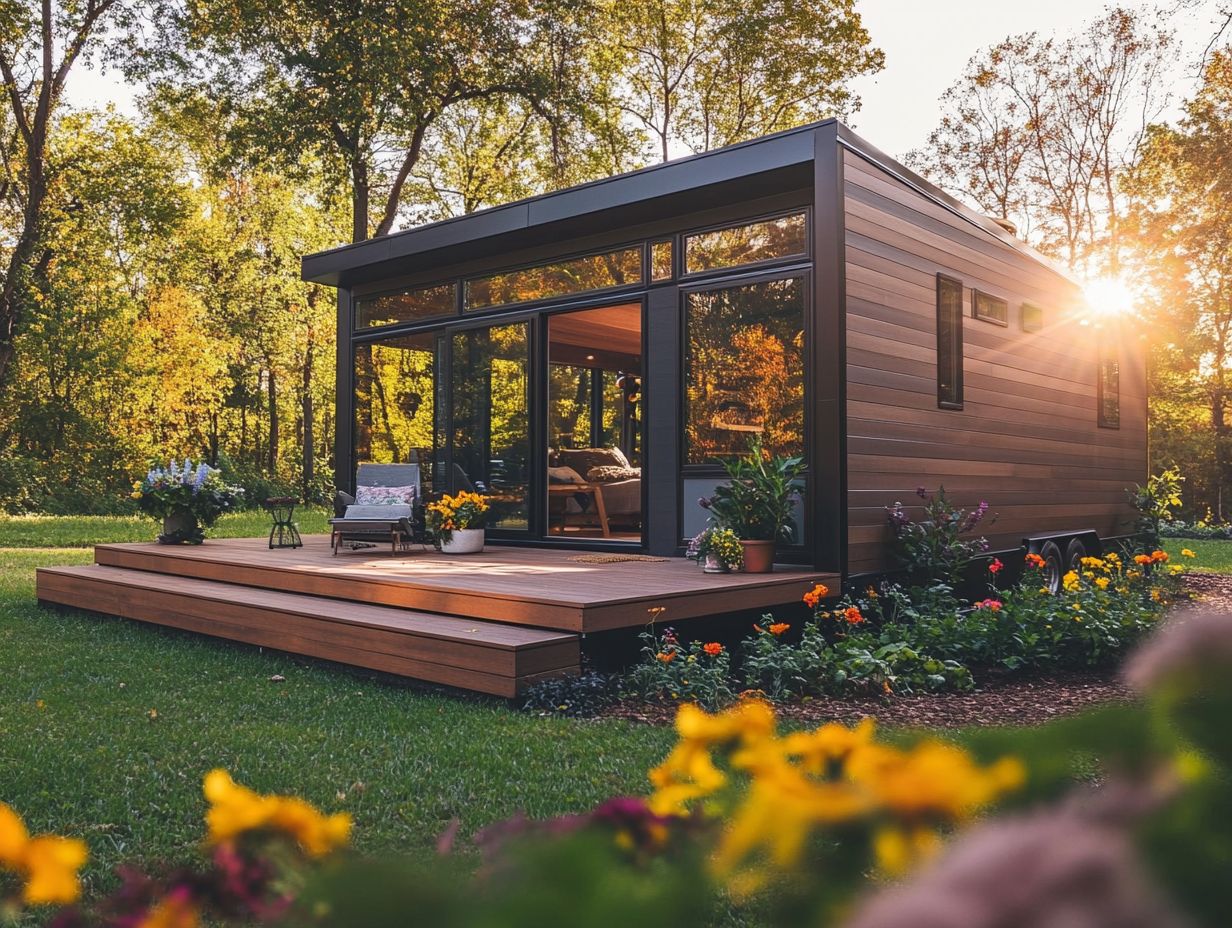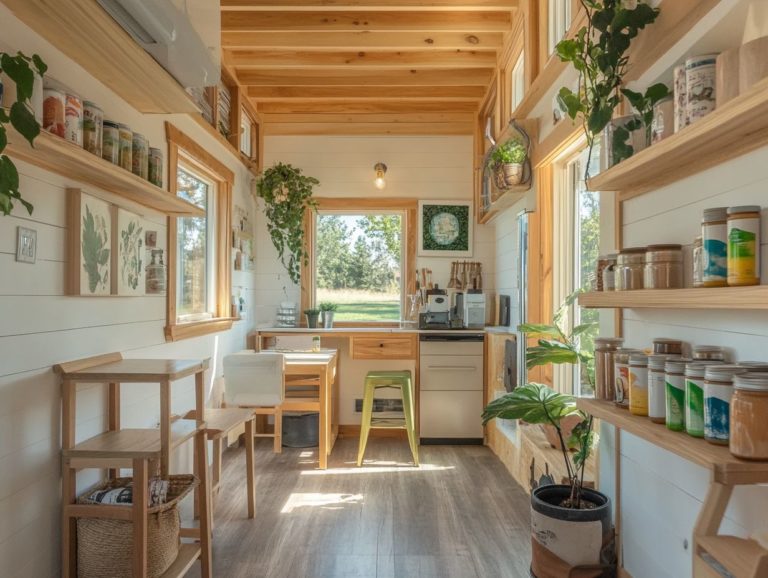The Benefits of Custom Tiny House Designs
In recent years, you’ve likely noticed that custom tiny houses have become an increasingly popular solution for those who crave a harmonious blend of affordability and sustainability in their living spaces.
These personalized homes give you the freedom to create unique layouts and features tailored to your specific needs. They promote an efficient use of space and resources. From remarkable cost savings to significant environmental benefits, custom tiny houses present a compelling choice for modern living.
Creating your dream tiny home is an exciting adventure! Let s explore the incredible benefits that await you, along with the advantages and considerations of custom tiny house designs. This guide will empower you to make informed decisions every step of the way.
Contents
- Key Takeaways:
- What is a Custom Tiny House?
- Personalization and Flexibility
- Cost and Efficiency
- Environmental Benefits
- Challenges of Custom Tiny House Designs
- Frequently Asked Questions
- What are the benefits of choosing a custom tiny house design?
- Can I save money by choosing a custom tiny house design?
- Will I have more control over the layout and design of my tiny house?
- What are the environmental benefits of custom tiny house designs?
- Can I customize the materials used in my tiny house design?
- Do I need any special permits or approvals for a tiny house design?
Key Takeaways:

- Custom tiny homes offer personalization and flexibility, letting you design a space that fits your unique lifestyle.
- They maximize space and functionality, ensuring you get the most out of every square inch.
- These homes are not just personal and cost-effective; they also help the planet by reducing your carbon footprint.
What is a Custom Tiny House?
A custom tiny house is a thoughtfully designed living space that embodies the principles of minimalism and sustainability. This approach allows you to fully embrace the benefits of alternative living communities while paving the way toward financial freedom.
Rooted in the tiny house movement, this concept focuses on cost-effective housing solutions that not only lower the initial investment but also champion eco-friendly technologies and create a reduced environmental footprint.
By incorporating elements like repurposed building materials and energy-efficient appliances, these homes create a perfect balance of comfort and functionality, inviting you to live more intentionally.
Personalization and Flexibility
Personalization and flexibility define the essence of custom tiny homes. You can craft a living space that seamlessly aligns with your lifestyle and preferences. Whether it s through distinctive layouts or tailored features, you have the power to create a home that is uniquely yours.
Customizing Layout and Features
Customizing the layout and features of your tiny home allows you to maximize limited living space. This ensures that every inch is optimized for both functionality and comfort.
This level of personalization often includes open floor plans that create the illusion of a larger environment. They enable seamless movement and flexibility for various activities. You might find yourself drawn to multifunctional furniture think fold-out tables and sofa beds that adapt to your needs throughout the day.
Innovative features like built-in storage solutions help you maintain an organized and clutter-free atmosphere. By incorporating smart home technology, you can optimize energy use and enhance overall efficiency, transforming tiny living into something not just practical, but also cozy and impressively high-tech.
Designing for Specific Needs
Designing a tiny home that meets your specific needs requires a deep understanding of what you truly value in your living space. This could be mobility or the perfect setup for your family. Tailoring the design to fit those unique requirements is essential.
Custom tiny home builders are key players in this endeavor, engaging with you through insightful consultations. They prioritize listening to your lifestyle habits, preferences, and any necessary accessibility features you might need, such as wider doorways or lower counters. Additionally, they can help you explore the benefits of hempcrete in tiny house design to create a more sustainable living space.
By taking a collaborative approach, they create innovative space-saving designs that maximize utility while ensuring your comfort. Whether it s incorporating multifunctional furniture or strategically placing storage solutions, the focus is always on crafting a personalized living environment that reflects your individual needs.
With careful attention to detail, your tiny home becomes a true reflection of you both functional and fabulous!
Cost and Efficiency

Cost and efficiency are key when considering a custom tiny home. These homes are known for being cost-effective while lowering both your initial investment and long-term expenses.
Saving Money with Custom Designs
Custom designs can lead to big savings. You can choose affordable options that boost your financial freedom.
Using reclaimed wood or recycled metal can cut building costs and give your space a unique charm. Installing energy-efficient technologies like solar panels and high-quality insulation helps reduce utility bills and supports a sustainable living environment.
For instance, using LED lighting and Energy Star appliances lowers expenses while promoting eco-friendliness. These smart choices help create a manageable construction budget and lower long-term costs, leading you toward financial freedom.
Maximizing Space and Functionality
Maximizing space in tiny homes is essential for a comfortable living environment. This leads to innovative designs that blend energy-efficient appliances with multi-use furniture.
Using smart storage solutions such as built-in shelves and foldable tables creates an open and inviting atmosphere in small spaces.
Modular designs add flexibility, allowing easy adjustments for different needs. Consider models like the Living Vehicle or the Tiny Home by the River to see how clever layouts make a small space feel functional.
These strategies enhance practicality and promote a minimalist lifestyle, inviting you to value quality over quantity.
Environmental Benefits
The environmental benefits of custom tiny homes go far beyond their compact dimensions. By choosing to live sustainably, you can lower your ecological footprint and harness renewable energy sources.
This decision benefits both you and the planet.
Reducing Carbon Footprint
Reducing your carbon footprint is a key goal for tiny home enthusiasts. You can focus on sustainable practices that lead to a greener future.
Consider installing solar panels to generate clean energy from your roof. You could also explore rainwater harvesting systems to collect rainwater for watering plants and flushing toilets.
Together, these solutions cut water and energy use while fostering a lifestyle that respects nature. They enhance the charm of tiny living and promote sustainability.
Using Sustainable Materials

Using sustainable materials in tiny home construction not only elevates their eco-friendly charm. It also champions the use of architectural salvage. This method reduces waste. It also supports sustainable practices, making you a conscious builder.
Take reclaimed wood, for example. It adds unique character to your space while significantly cutting down the demand for new lumber. This ultimately lowers the amount of pollution your home creates. Then there s bamboo. Renowned for its rapid growth and strength, it is an exceptional choice for flooring and structural elements. You can source this material responsibly from certified producers who prioritize sustainable harvesting.
Opting for recycled metal roofing doesn t just ensure durability; it also signifies your steadfast commitment to resource conservation. When you incorporate materials like hempcrete or straw bales, you can achieve impressive insulation properties. This enhances the energy efficiency of your tiny home.
By sourcing these materials from local suppliers, you re not only supporting the local economy but also minimizing transportation footprints. This perfectly aligns with sustainability principles.
Challenges of Custom Tiny House Designs
While the appeal of custom tiny house designs is undeniable, you may encounter several challenges along the way. Especially when it comes to navigating permitting and zoning regulations that can complicate the building process.
Permitting and Zoning Regulations
Navigating permitting and zoning regulations can feel overwhelming when you’re pursuing a custom tiny house. These regulations vary significantly among local municipalities and can greatly influence the feasibility of your project.
Understanding local zoning laws is essential to avoid costly setbacks. It ensures your tiny home vision aligns with community ordinances. Each area has its own rules regarding where tiny homes can be located, the minimum square footage, and even the type of utilities required. Additionally, exploring the benefits of living in a tiny house community can provide valuable insights into your decision-making process.
You can greatly benefit from resources like the American Tiny House Association and local housing authorities, which offer valuable insights and guidance. Connecting with local builders or joining tiny house forums can also provide practical assistance and shared experiences. Additionally, understanding the importance of scale in tiny house design simplifies the permitting process, making it much more manageable.
Finding a Builder
Finding a qualified tiny house builder who understands local zoning laws and has a knack for custom designs can significantly influence the success of your tiny home project.
As you embark on this exciting journey, there are several factors to consider that will help ensure a smooth experience. Start by checking the builder’s credentials. Verifying their licenses and insurance is crucial to affirming their legitimacy. Then, take a moment to examine their portfolio, which should showcase previous projects and highlight their unique design capabilities.
Don’t underestimate the power of reviews. Feedback from past clients can provide invaluable insights into their reliability and craftsmanship. By selecting the right builder, you can streamline the construction process and gain expertise in navigating those complex zoning regulations. This ultimately leads to a truly successful tiny house experience, especially when considering the benefits of open floor plans.
Frequently Asked Questions
What are the benefits of choosing a custom tiny house design?

Custom tiny house designs allow for personalization and optimization of space. This makes it a perfect fit for your lifestyle and needs.
Can I save money by choosing a custom tiny house design?
Yes, custom tiny house designs can save you money in the long run. They do this by eliminating unnecessary features and maximizing efficiency.
Will I have more control over the layout and design of my tiny house?
Absolutely! With a custom tiny house design, you have complete control over the layout, design, and overall aesthetic of your home.
What are the environmental benefits of custom tiny house designs?
Custom tiny house designs have a smaller carbon footprint than traditional homes. They use fewer materials and consume less energy, helping the planet.
Can I customize the materials used in my tiny house design?
Absolutely! You can select sustainable and eco-friendly materials. This choice makes your tiny house even better for the environment.
Do I need any special permits or approvals for a tiny house design?
Check your local regulations. Usually, custom tiny houses follow the same rules as RVs or mobile homes.






